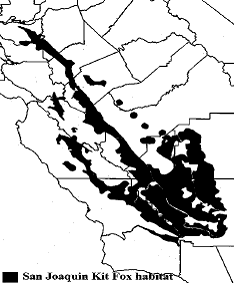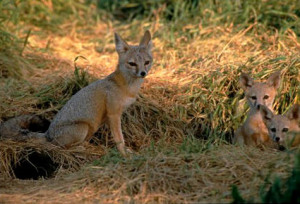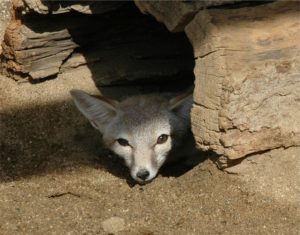Vulpes macrotus mutica
- Endangered – Endangered Species Act (1967)
- Threatened – California Endangered Species Act (1971)
While weighing in at only five pounds, the San Joaquin kit fox is not your average toy poodle (though they are related to dogs, wolves, and other canine species). They are the smallest foxes in North America, but their ears are much larger than other foxes, making them well-adapted to living in hot, dry areas. Their large ears may help dissipate body heat and also help them focus on tiny noises in the night, such as insects or mice. San Joaquin kit foxes can survive without freshwater, obtaining enough fluids from their prey alone. Their heavily pigmented eyes provide protection from the fierce sun, and the large amount of hair on the soles of their feet may protect them from hot soil.
San Joaquin kit foxes are primarily active at night, hunting kangaroo rats and other small rodents, ground squirrels, birds, and insects throughout the night along with their main food source, grass. They will sometimes rest and play near their dens during the afternoons, but become most active near sunset and throughout the night. Two distinctive coats develop each year: a tan summer coat and a silver-gray winter coat.
Kit foxes use a variety of open habitats like grassland, scrubland, and meadows. They are considered to be umbrella species because their habitat requirements overlap with many other imperiled species. Efforts to protect the kit fox will benefit many other wildlife species.
Underground Dwellers
Like other species in the canine family, kit foxes are denning creatures, relying on underground shelters for regulating temperatures, avoiding predators, and raising their young. San Joaquin kit foxes commonly use dens constructed by other animals, and move around often. In fact, they can have up to thirty multi-chambered dens each year! They don’t leave much evidence behind that they’re using a particular den, making it extremely important to protect all remaining den sites, even if they appear to be unused.
San Joaquin kit foxes typically change dens four or five times during the summer. Scientists think that this frequent change of dens might be a way for the foxes to avoid coyotes. Researchers have reported individual foxes using more than 20 den sites annually and family groups using as many as 43. In another study, a single animal used 70 different dens over a two-year period. San Joaquin kit foxes on the Carrizo Plain seem to change dens more frequently, spending only 2-3 days in a den before moving to a different location.
At night, the San Joaquin kit fox roams an average of nine miles in search of prey. Sometimes, kit foxes will have home ranges of less than one square mile, while others may have territories up to twelve square miles.
Kit foxes are able to breed when they’re one year old and adult pairs typically stay together all year. Litters of two to six pups are born in February or March. While the female is lactating the male provides most of the food for her and the pups. Pups emerge above ground around one month of age, and after 4-5 months, the family bonds begin to dissolve and the young begin dispersing. Sometimes, offspring remain with their parents through the following year and help raise a subsequent litter. Kit foxes can live up to eight years.
Threats & Current Status
Prior to 1930, kit foxes inhabited the entire San Joaquin Valley in central California, as well as the lower elevations of the eastern Coast Ranges. Today, kit fox populations have declined by as much as 33%, and they are now limited to the west side of the San Joaquin valley and in the Los Padres National Forest. Kit foxes are found in the Carrizo Plain National Monument as well as the Los Padres National Forest in the upper Cuyama Valley and on the eastern slopes of the La Panza Range in San Luis Obispo County. Now highly scattered and fragmented, the largest remaining populations are in western Kern County, Kern County, and in the Carrizo Plain. The Carrizo Plain is the largest of the three remaining core populations, making this area vital to the recovery of the species.
 In 1967 the San Joaquin kit fox was listed as a federally endangered species, and in 1971 the State of California listed it as a threatened species because of a dramatic decline in habitat. Much of the habitat for the kit fox has been developed for agricultural and industrial development. Development leads to fragmentation and isolation, making it difficult to find shelter, mates and food. Human caused mortalities are primarily due to vehicle strikes and also shooting, trapping, and poisoning. Off-road vehicular use can lead to the collapse and suffocation of kit foxes. Oil development also threatens kit fox populations. At least four kit foxes have drowned in pools of oil and others have lodged themselves in pipes or oil well cellars. Roads associated with oil development can fragment kit fox habitat and result in increased vehicle strikes, and land clearing for roads and oil pads can collapse or bury den sites. Intense livestock grazing that destroys shrub cover and reduces prey abundance may also be detrimental to kit foxes.
In 1967 the San Joaquin kit fox was listed as a federally endangered species, and in 1971 the State of California listed it as a threatened species because of a dramatic decline in habitat. Much of the habitat for the kit fox has been developed for agricultural and industrial development. Development leads to fragmentation and isolation, making it difficult to find shelter, mates and food. Human caused mortalities are primarily due to vehicle strikes and also shooting, trapping, and poisoning. Off-road vehicular use can lead to the collapse and suffocation of kit foxes. Oil development also threatens kit fox populations. At least four kit foxes have drowned in pools of oil and others have lodged themselves in pipes or oil well cellars. Roads associated with oil development can fragment kit fox habitat and result in increased vehicle strikes, and land clearing for roads and oil pads can collapse or bury den sites. Intense livestock grazing that destroys shrub cover and reduces prey abundance may also be detrimental to kit foxes.
Protecting the Kit Fox
Forestwatch helps protect San Joaquin kit foxes and their habitat from fragmentation and habitat loss. We’ve demanded strict wildlife protection standards in the management plans for the Carrizo Plain National Monument and the Los Padres National Forest to ensure that remaining kit fox habitat remains unfragmented and intact.
ForestWatch has also worked to prevent new oil development in ecologically sensitive kit fox habitat. We work to ensure that other activities like livestock grazing and off-road vehicle use are compatible with kit fox protection and recovery. ForestWatch is also encouraging the U.S. Forest Service to conduct surveys to determine the presence of kit fox dens on the Los Padres National Forest so that their habitat can be protected.
More Information
Read the kit fox’s species account.
Read the kit fox’s recovery plan.
Fun Facts
- Kit foxes are the smallest foxes in North America, weighing only about five pounds.
- San Joaquin kit foxes can survive without freshwater, getting all of their fluids from what they eat.
- Their large ears may help dissipate body heat and detect tiny noises.
- Kit foxes are an umbrella species – protecting their habitat will protect several other imperiled species, too.
- Kit foxes might move between 30 different dens each year, and can roam up to 9 miles each night in search of food.
- The largest remaining San Joaquin kit fox population is on the Carrizo Plain.








